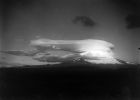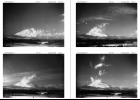Figures of Nihilism in Vilém Flusser’s Philosophy
This essay focuses on the role of nihilism in the development of Vilém Flusser’s work, a notion that plays a major role at the beginning of his intellectual adventure and keeps resurfacing in various guises and different moments. Nihilism is linked to certain people and the work of certain philosophers: to his friend Alex Bloch and the work of Albert Camus, Friedrich Nietzsche, and Vicente Fereira da Silva. It appears in The History of the Devil, the autobiography Bodenlos and Vampyroteuthis Infernalis. Nihilism is connected to a series of topics: the forces of negativity and denial, the absurdity and groundlessness of human existence, the meaninglessness of life and the temptation of suicide, the concept of nothingness in Jewish thinking and the void in Oriental philosophy, the devil and the diabolical abyss, Mephistopheles and the infernal octopus at the bottom of the sea, and finally the zero-dimensionality of pixels and the principle of entropy. Flusser repeatedly spoke of himself in Mephistophelian terms and called his life in Brazil a diabolical existence. Samson Flexor painted a portrait of Vilém Flusser that strongly accentuated the diabolical side of his person. Louis Bec’s various species of Vampyroteuthis Infernalis represent different sides of Flusser’s thinking.
Aberturas / Opening
“Openings” is the first of four essays written by Vilém Flusser regarding the work of Russian-Brazilian painter Samson Flexor (1907-1971). Published in “Suplemento Literário do Estado de São Paulo”, the article is marked by a heideggerian-existentialist style and presents what is probably Flusser's first concrete dive into a monstrous imaginary during his years in Brazil, where the philosopher lived between 1940 and 1973. Flusser's essays on Flexor are dated between 1967 and 71 and cover the “Bipeds” phase and the so-called “white” phase from the painter’s work. Later he would write one last essay, called “Flexor: in memoriam”, for the painter’s biography, written by Alice Brill in 1990. This Portuguese-English translation of “Aberturas” includes one photograph of Flexor with some of his "Bipeds" at the IX Bienal de São Paulo, in 1967.
Die Dimension der Leere. Vedanta und Buddhismus in Vilém Flussers Das Zwanzigste Jahrhundert und Bodenlos
This short essay explores some of the connections between Vilém Flusser’s study of eastern philosophy in the 1940s and 1950s and his later notion of zero dimensionality. In his first book, Das Zwanzigste Jahrhundert, he pointed to a theoretical convergence between the Indian Vedanta, Buddhism and modern natural sciences. In his autobiography, Bodenlos, written in the early 1970s Flusser reevaluated his former interest in oriental philosophy in highly critical terms. However, despite this attempt at distancing, some of the notions from Das Zwanzigste Jahrhundert infiltrated his late vision of an emerging universe of technical images.
Mountains and Clouds: Flusser’s Buddhism
Flusser encountered Zen Buddhism in the 1950s through his friend Alex Bloch who was assistant to a Zen monk. What would this mean for Flusser’s thinking and writing? This essay engages in the contradictory project of exploring Flusser’s Buddhism both from within his writing and from the outside, through Buddhist texts Flusser would not have read. Flusser’s experiences with meditation and Buddhist thought are described in autobiographical passages of Groundless and The History of the Devil, including some unusual moments of “enlightenment.” How did these linger in Flusser’s philosophical speculations? Flusser’s phenomenological essay “Mountains” from Natural:Mind is read against the work of Chinese poet Du Fu and Zen master Eihei Dogen, and the distinction between nothingness and emptiness is considered.
From God’s Death and Nothingness to the Re-Creation of the World: Vilém Flusser’s Intertextual Games
The essay deals with several motifs of Vilém Flusser’s philosophy focusing on the notion of nothingness – ontological horizon, conversation and establishment of being. The essay attempts to reconstruct the fundamentals of Flusser’s theory of being, based on an analysis of his fragmentary statements, which form a coherent whole grounded in a utopian vision of information society influenced by Aristotle, Kant, Nietzsche, Heidegger, Ingarden, Sartre and Levinas. Flusser’s writings are intertexts full of more or less concealed allusions, transformations, and polemics, as well as of congenial convergences with texts and ideas of other authors.
Fluss/er. Circle – Spiral – Cloud
This text is an attempt to capture Flusser’s thinking and its evolution over the years by focusing on three interrelated images: the circle, the spiral and the cloud. The first two are based on Flusser’s translation and retranslation theory, which negates the notions of simple progress, linearity and hierarchy. The third one is related to the last phase of Flusser’s thinking organized around the notions of calculation and the dot-like structure of digital images. Clouds are seen as swarms of free-floating points of view created by calculatory combination, as fields of possibility. The text begins with a short reflection on Flusser’s own name suggesting a direct link between it and some central tenets of his philosophy. The proper name Flusser is an image that can be used to interpret Vilém Flusser’s own thinking.

